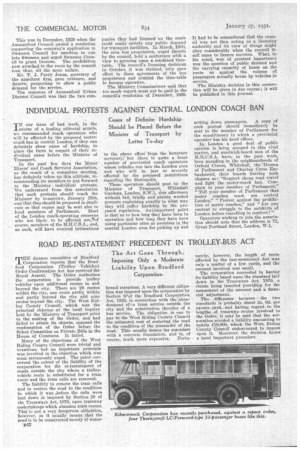ROAD RE-INSTATEMENT PRECEDENT IN TROLLEY-BUS ACT
Page 60

If you've noticed an error in this article please click here to report it so we can fix it.
The Act Goes Through, Imposing Only a Moderate Liability Upon Bradford Corporation THE finance committee of Bradford Corporation reports that the Bradford Corporation (Trolley Vehicles) Order Confirmation Act. has received the Royal Assent.' The Order authorizes the corporation to provide trolley vehicles upon additional routes in and beyond the city. There are 28 routes within the city, one route partly within and partly beyond the city and nine mutes beyond the city. The West Riding Comity Council, which was the principal objector at the local inquiry held by the Ministry of Transport prior to the making of the Order, and had failed to attain its objects, opposed the confirmation of the Order before the Select Committee on Private Bills in the House of Commons. It failed.
Many of the objections of the West Riding County Council were trivial and vexatious, but an important principle was involved in the objection which was most strenuously urged. The point concerned the extent of the liability of the corporation for the re-instatement of roads outside the city where a trolleyvehicle route is substituted for a train route and the tram rails are removed.
The liability to remove the tram rails and to restore the road to the condition in which it was ,before the rails were laid down is imposed by Section 28 of the Tramways Act, 1870, upon tramway undertakings which abandon tram routes. This isact a very dangerous obligation, however, as it usually means that the road is to be constructed merely of water bound macadam. A very different obligation Was imposed upon the corporation by Section 8l.of the Bradford Corporation Act, 1928, in connection with the-abandonment of 'a tram service outside the city and the substitution therefor of a bus service. The obligation is one to pay to the West Riding County Council the estimated cost of restoring the road to the conditionof the remainder of the road. This usually means tar macadam with a concrete foundation, and is, of course, much more expensive. Fortu
nately, however, the length of route affected by the last-mentioned Act was only a matter of a few yards, and the amount involved was small.
The corporation succeeded in having its liability based upon the standard laid down in the Tramways Act, 1870, a clause being inserted providing for the ' ossessment of the amount and a financial Adjustment.
difference between the two standards is probably about 2s. fid. per square yard,. and having regardto the lengths of tramwayroutes involved in the Order, it may be said :that the corporation avoided a liability amounting to nearly £10,000, which the West Riding
• County Council endeavoured to ,impose upon it. Moreover, the decision forms a most important precedent. '




































































































